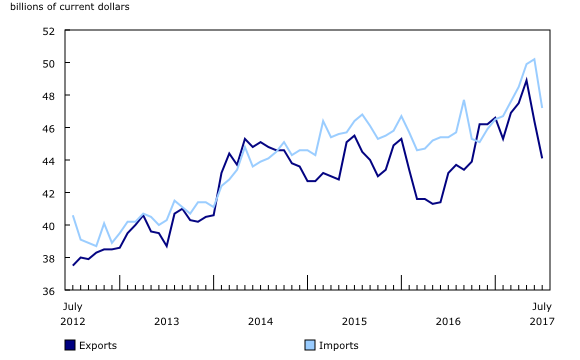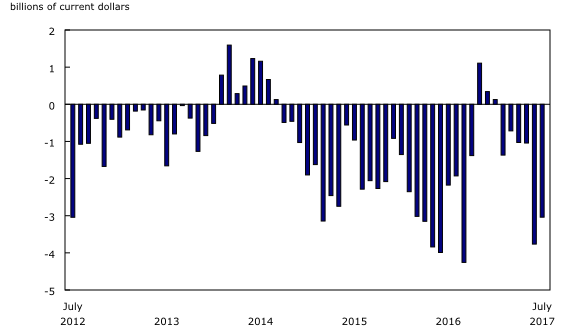Canadian international merchandise trade, July 2017
Archived Content
Information identified as archived is provided for reference, research or recordkeeping purposes. It is not subject to the Government of Canada Web Standards and has not been altered or updated since it was archived. Please "contact us" to request a format other than those available.
Released: 2017-09-06
Canada's merchandise trade deficit totalled $3.0 billion in July, narrowing from a $3.8 billion deficit in June. Imports fell 6.0% and exports decreased 4.9%, both due mainly to the effect of widespread price decreases, while the Canadian dollar appreciated sharply relative to the American dollar in July.
Widespread declines in imports in July
Total imports fell 6.0% in July to $47.2 billion, following seven consecutive monthly increases, with declines observed in all commodity sections. Prices were largely responsible for this decrease, falling 3.8%. This occurred as the Canadian dollar gained 3.6 cents US relative to the American dollar from June to July.
The decrease in import values was partially attributable to aircraft and other transportation equipment and parts, as well as motor vehicles and parts. Year over year, imports rose 4.0%.
Following a record observed in June, imports of aircraft and other transportation equipment and parts fell 35.2% to $1.6 billion in July. Aircraft imports led this decrease, with a slowdown in imports of airliners in July after two months of strong growth.
Imports of motor vehicles and parts also contributed to the decline, down 4.4% to $9.1 billion. Imports of motor vehicle engines and motor vehicle parts (-13.0%) were responsible for the decrease in July, as planned closures in the automotive manufacturing industry were longer this year. Overall, prices in the section declined 2.6% and volumes decreased 1.8%.
Lower export values mainly due to prices
After posting a 5.0% decline in June, total exports fell 4.9% in July to $44.1 billion, with decreases observed in 9 of 11 sections. Prices decreased 3.9%, while volumes were down 1.1%. Motor vehicles and parts, as well as aircraft and other transportation equipment and parts contributed the most to the decline. In July, exports excluding energy products were down 5.2%. Year over year, total exports were up 2.2%.
Exports of motor vehicles and parts fell 9.6% to $7.4 billion in July, the strongest decrease since August 2014. Exports of passenger cars and light trucks (-12.6%) were mostly responsible for the decline. As was the case with imports of motor vehicle engines and motor vehicle parts, longer planned closures in the automotive manufacturing industry in July were behind the decrease. Overall, prices were down 4.5% and volumes decreased by 5.4%.
Exports of aircraft and other transportation equipment and parts were down 18.3% in July to $1.8 billion, following four consecutive monthly increases. Exports of aircraft led the decline, falling 23.9% due to lower exports to the United States.
Decline in imports from the United States
Imports from the United States decreased 6.7% to $30.4 billion in July, led by lower aircraft imports. Exports to the United States were down 3.2% to $33.3 billion, mainly on lower exports of passenger cars and light trucks. As a result, Canada's trade surplus with the United States widened from $1.8 billion in June to $2.9 billion in July.
Exports to countries other than the United States declined 10.0% in July to $10.8 billion, with the United Kingdom (unwrought gold), Japan (copper, canola and seafood) and Saudi Arabia (personal transportation equipment) posting the largest decreases. Imports from countries other than the United States were down 4.7% to $16.8 billion in July, with Brazil (bauxite) and Mexico (motor vehicle parts) contributing the most to this decrease. Consequently, Canada's trade deficit with countries other than the United States rose from $5.6 billion in June to $5.9 billion in July.
Real trade deficit narrows in July
In real (or volume) terms, imports decreased 2.3% and exports were down 1.1% in July. Consequently, Canada's trade deficit in real terms narrowed from $891 million in June to $338 million in July.
Revisions to exports and imports
Revisions reflected initial estimates being updated with or replaced by administrative and survey data as they became available, as well as amendments made for late documentation of high-value transactions. Exports in June, originally reported as $46.5 billion in last month's release, were revised to $46.4 billion in the current month's release. However, exports in May, originally reported as $48.6 billion in June's release, were revised to $48.9 billion on revisions applied to energy prices. June imports, originally reported as $50.1 billion in last month's release, were revised to $50.2 billion.

In celebration of the country's 150th birthday, Statistics Canada is presenting snapshots from our rich statistical history.
The oil crises of the 1970s and 1980s
The oil crises of the 1970s and 1980s had a significant impact on Canadian trade activity. The oil embargo by the Organization of the Petroleum Exporting Countries against the United States and Western countries in 1973, along with the Iran-Iraq War in 1980, both contributed to large worldwide oil price increases.
In Canada, the value of crude oil imports increased eightfold between 1973 and 1981, totalling $8 billion in 1981. This gain was entirely due to increases in prices, which were 14 times higher in 1981 than in 1973.
During the same period, the volume of Canadian crude oil imports fell by more than 75%, mostly on lower imports from Iran and Iraq. In 1975, more than one-quarter of Canadian imports of crude oil came from Iran or Iraq; in 1980, during the war between those two countries, there were no imports of crude oil coming from them.
Canadian crude oil exports represented approximately one-third of Canadian crude oil imports in 1981.
Note to readers
Merchandise trade is one component of Canada's international balance of payments (BOP), which also includes trade in services, investment income, current transfers and capital and financial flows.
International trade data by commodity are available on both a BOP and a customs basis. International trade data by country are available on a customs basis for all countries and on a BOP basis for Canada's 27 principal trading partners (PTPs). The list of PTPs is based on their annual share of total merchandise trade—imports and exports—with Canada in 2012. BOP data are derived from customs data by making adjustments for factors such as valuation, coverage, timing and residency. These adjustments are made to conform to the concepts and definitions of the Canadian System of National Accounts.
For a conceptual analysis of BOP versus customs-based data, see "Balance of Payments trade in goods at Statistics Canada: Expanding geographic detail to 27 principal trading partners."
For more information on these and other macroeconomic concepts, see the Methodological Guide: Canadian System of Macroeconomic Accounts (13-607-X) and User Guide: Canadian System of Macroeconomic Accounts (13-606-G).
Data in this release are on a BOP basis, seasonally adjusted and in current dollars. Constant dollars are calculated using the Laspeyres volume formula (2007=100).
For information on seasonal adjustment, see Seasonally adjusted data – Frequently asked questions.
Revisions
In general, merchandise trade data are revised on an ongoing basis for each month of the current year. Current-year revisions are reflected in both the customs and BOP-based data.
The previous year's customs data are revised with the release of the January and February reference months, and then on a quarterly basis. The previous two years of customs-based data are revised annually and revisions are released in February with the December reference month.
The previous year's BOP-based data are revised with the release of the January, February, March and April reference months. To remain consistent with the Canadian System of Macroeconomic Accounts, revisions to BOP-based data for previous years are released annually in December with the October reference month.
Factors influencing revisions include the late receipt of import and export documentation, incorrect information on customs forms, replacement of estimates produced for the energy section with actual figures, changes in classification of merchandise based on more current information, and changes to seasonal adjustment factors.
For information on data revisions for crude oil and natural gas, see "Revisions to trade data for crude oil and natural gas."
Revised data are available in the appropriate CANSIM tables.
Real-time CANSIM tables
Real-time CANSIM table 228-8059 will be updated on September 18. For more information, consult the document Real-time CANSIM tables.
Next release
Data on Canadian international merchandise trade for August will be released on October 5.
Products
Customs based data are now available in the Canadian International Merchandise Trade Database (65F0013X).
The updated Canada and the World Statistics Hub - United States (13-609-X) is now available from the home page of the Statistics Canada website. This new product illustrates the nature and the extent of Canada's economic and financial relationship with the United States using interactive graphs and tables. This product provides easy access to information on trade, investment, employment and travel, including merchandise trade by Canadian provinces and US states.
Contact information
For more information, contact us (toll-free 1-800-263-1136; 514-283-8300; STATCAN.infostats-infostats.STATCAN@canada.ca).
To enquire about the concepts, methods or data quality of this release, contact Benoît Carrière (613-415-5305; benoit.carriere@canada.ca), International Accounts and Trade Division.
- Date modified:




